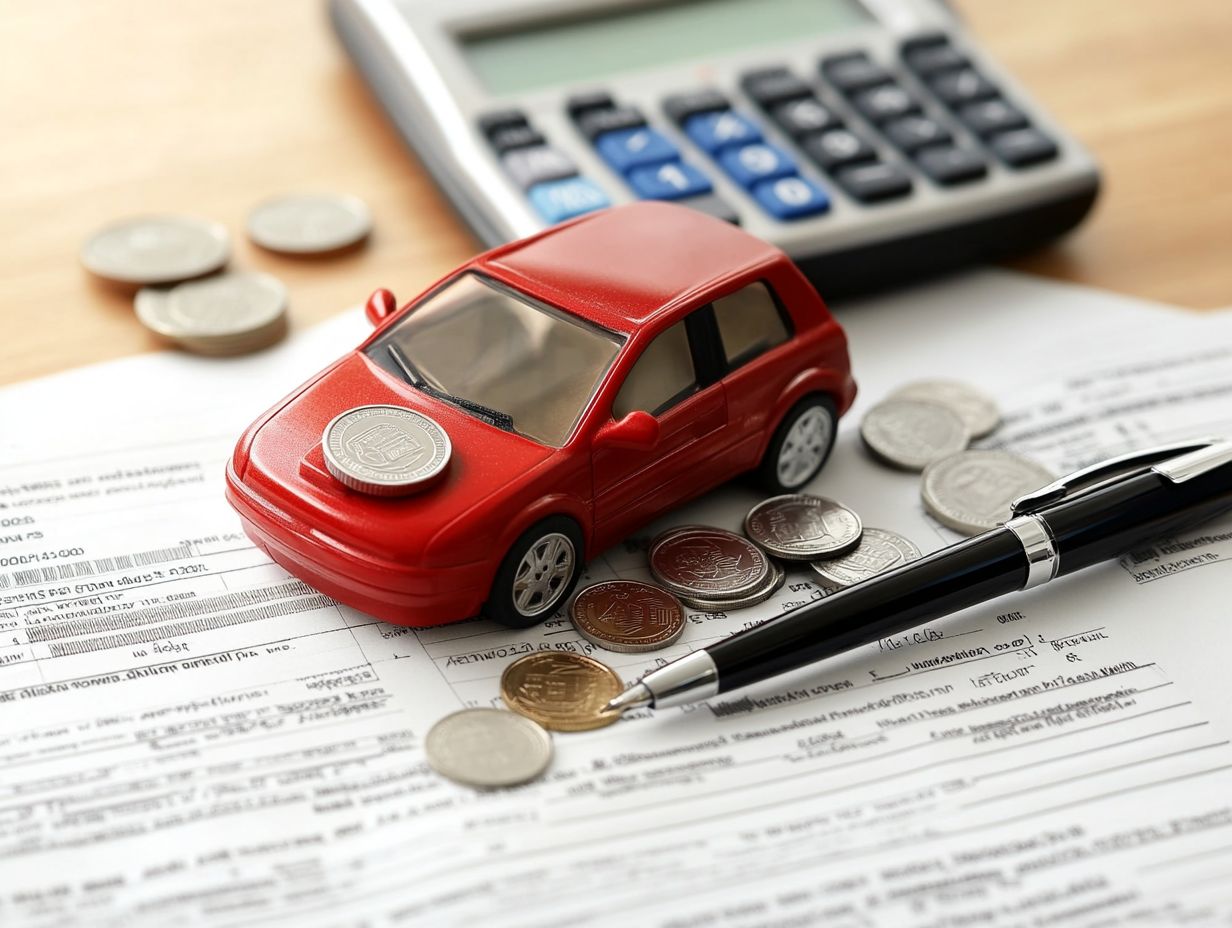How Does Deductible Work in Auto Insurance?
Auto insurance deductibles are foundational to understanding how your coverage operates. They can greatly influence your overall expenses.
By grasping what a deductible truly is, you can make informed decisions tailored to your financial landscape. Recognizing its effect on your premiums and exploring the various types available is equally important.
From collision and comprehensive deductibles to savvy saving strategies, this guide empowers you to master the essentials of auto insurance deductibles! Make informed choices today to protect your wallet!
Contents
Key Takeaways:

- Understanding auto insurance deductibles is essential for choosing the right coverage for your car.
- The relationship between deductibles and premiums is straightforward: the higher the deductible, the lower the premium, and vice versa.
- When deciding on a deductible, consider your budget, risk tolerance, and the value and usage of your vehicle.
Understanding Auto Insurance Deductibles
It s essential to understand auto insurance deductibles. A deductible is how much you pay before insurance helps cover the remaining costs associated with a claim.
This affects your insurance premium and coverage options, including collision coverage, comprehensive coverage, and personal injury protection. Different insurance companies present a range of deductible options, and knowing how to select an appropriate one is crucial.
What is a Deductible?
A deductible in auto insurance is the specific amount you must pay out of pocket toward a covered loss before your insurance company steps in. This financial responsibility serves as a safety net for the insurer, ensuring that you share a portion of the risk involved.
Deductibles can vary widely based on the type of coverage you choose whether it s collision or comprehensive. They often range from a few hundred to several thousand dollars. Factors influencing this range include your driving history, the value of your vehicle, and state regulations.
Opting for a higher deductible may lead to lower premium payments, but it also means you could face more out-of-pocket expenses when you file a claim. Grasping this balance is essential for effective financial planning.
How Deductibles Affect Insurance Premiums
The connection between deductibles and insurance premiums is crucial if you’re looking to manage your auto insurance expenses wisely. Typically, a higher deductible can result in lower premium rates because the insurance company views you as posing a reduced claim risk.
Conversely, a lower deductible usually means higher premiums. By grasping this relationship, you can make informed choices about your coverage limits and overall financial standing.
The Relationship Between Deductibles and Premiums
The relationship between deductibles and insurance premiums significantly influences your approach to auto insurance choices. By understanding how various deductible amounts impact premium rates, you can make informed decisions that align with your financial capabilities.
If you choose higher deductibles, you ll typically enjoy lower monthly premiums. However, this trade-off means you’ll face higher out-of-pocket expenses if a claim arises.
On the other hand, opting for a lower deductible usually results in increased premium costs. However, it offers a valuable safety net, especially if you don t have a financial cushion for a hefty repair bill. Evaluating your personal circumstances like income stability and savings reserves can help you select the right deductible that strikes a balance between affordability and adequate coverage.
Types of Deductibles in Auto Insurance

Understanding the different types of deductibles in auto insurance can save you money and stress! The two main types to consider are collision deductibles and comprehensive deductibles. Each is tailored to distinct facets of your insurance policy.
Collision deductibles come into play when your vehicle suffers damage in an accident. Comprehensive deductibles address non-collision incidents, such as theft or natural disasters.
It’s important to carefully assess your specific needs and risk factors. This will allow you to select the most appropriate deductible options that align with your individual circumstances.
Collision Deductibles
Collision deductibles are an important part of collision coverage in auto insurance. They determine the out-of-pocket expense you ll need to cover when your vehicle suffers damage from a collision.
Think of these deductibles as a way of splitting costs between you and your insurer. This shapes the claims process when accidents inevitably happen. For example, if you find yourself in a minor fender-bender, the deductible is the amount you must pay before your insurance steps in to cover the remaining repair costs. This influences whether you decide to file a claim, particularly in minor accidents where the repair costs might be close to or even less than your deductible.
Thus, grasping how collision deductibles function not only aids in planning for potential expenses but also plays a crucial role in managing your auto insurance policy with confidence.
Comprehensive Deductibles
Comprehensive deductibles apply to comprehensive coverage, which safeguards you against a wide range of risks beyond just collisions, including theft, vandalism, and natural disasters.
This type of coverage becomes particularly essential if you live in areas prone to severe weather. Threats like hail or flooding could wreak havoc on your vehicle. Unlike collision deductibles that cover damage solely from accidents involving other vehicles or objects, comprehensive deductibles address a broader spectrum of circumstances that could affect your vehicle’s value.
For example, if you’re the unfortunate victim of a break-in and your stereo system is stolen, you’ll turn to your comprehensive coverage. Making that specified deductible crucial for your claim is vital. Knowing these deductibles helps you compare insurance quotes better, ensuring you choose a plan that adequately protects your investment in various situations.
Combined Deductibles
Combined deductibles present a sophisticated way to manage your auto insurance expenses. They merge both collision and comprehensive deductibles into a single, streamlined figure.
This strategy simplifies the claims process and allows you to easily grasp your financial responsibilities should an accident or damage occur. When a single deductible applies, it can significantly lessen your overall out-of-pocket expenses during claims, especially if you hold both types of coverage.
The synergy of combined deductibles can be advantageous across various insurance policies, offering flexibility tailored to your specific needs.
This approach encourages you to be more mindful of your coverage limits, potentially leading to lower premium costs. Ultimately, it aims to enhance your accessibility to protection while making insurance expense management more straightforward and efficient.
Factors to Consider When Choosing a Deductible
When choosing a deductible for your auto insurance, several critical factors demand your attention. They can greatly impact your financial well-being.
First and foremost, consider your budget. The deductible amount you opt for should align seamlessly with your financial situation and your capacity to handle out-of-pocket expenses in the event of a claim.
Also, think about your risk factors, such as your driving habits and the value of your vehicle. These insights will guide your deductible selection, enabling you to find the perfect balance between comprehensive coverage and affordable costs.
Budget and Risk Tolerance

Budget and risk tolerance are essential elements to weigh when selecting a deductible for your car insurance policy.
By closely examining your personal finances, you can determine how much you’re comfortable paying upfront if an accident occurs. If you have a healthy emergency fund, you might lean toward a higher deductible, knowing you can handle those immediate costs. Conversely, if you’re living paycheck to paycheck, a lower deductible may be wiser, as it helps avoid unexpected expenses.
Consider your driving habits and the age of your vehicle as these factors can significantly impact both premium costs and coverage needs. A new car owner might appreciate the peace of mind that comes with a lower deductible, safeguarding against potential repair bills. In contrast, a seasoned driver with an older vehicle may find a high deductible more acceptable, balancing lower monthly payments with the possibility of higher out-of-pocket repair costs.
Vehicle Value and Usage
The value and usage of your vehicle greatly influence the most appropriate deductible for your auto insurance coverage.
If you own a new luxury car, opting for a lower deductible makes sense due to its higher replacement cost. On the other hand, if your vehicle is older and less valuable, a higher deductible might be a more sound choice. Your vehicle’s frequency of use also plays a crucial role; someone who commutes daily will likely have different deductible needs than someone who drives only for weekend adventures.
Understanding these nuances allows you to make smarter financial choices and align your policy more effectively. This balance between your vehicle’s worth and its everyday use shapes your insurance needs meaningfully.
How to Pay for a Deductible
Paying for a deductible can be a seamless experience with meticulous planning and a clear understanding of your options.
When you file a claim, you ll need to cover the deductible amount out of pocket before your insurance company pays for the repair costs or damages specified in your policy. Familiarize yourself with your deductible options and anticipate any potential out-of-pocket expenses, especially in situations involving big repairs or multiple claims.
Options for Covering the Cost
Explore exciting options to cover your deductible today!
- One effective strategy is to set up a dedicated savings plan specifically for this purpose. By consistently contributing to this fund, you can build a safety net that eases the financial burden when unexpected situations arise.
- You can also explore financial products like dedicated insurance riders that reduce deductibles, providing you with invaluable peace of mind. Many insurance companies offer programs or financial assistance designed to help policyholders manage their deductible payments more easily.
Understanding these avenues enables you to make informed decisions that enhance your financial resilience.
Tips for Saving on Deductibles
Saving on deductibles doesn’t have to be a complicated task. By implementing a few strategic tips, you can effectively reduce your out-of-pocket expenses when filing a claim.
One smart move is to explore the insurance discounts your provider may offer, which can help lower your premiums and your deductible amounts.
Grasping the significance of claim risk can steer you towards safer driving habits, potentially unlocking even more savings down the line.
Ways to Lower Your Deductible

You have several ways to lower your deductible. This can make your auto insurance more manageable over time.
By examining your options, you might find that increasing your coverage can offer better terms and more protection. Talk directly to your insurance provider to see if you can reduce your deductibles.
Take advantage of various discounts. For example, maintaining a safe driving record or combining different policies can significantly lower your overall costs.
If you have a clean record, you could unlock a fantastic discount that reduces both your deductible and premium!
Using these strategies can help alleviate financial stresses when filing a claim.
Frequently Asked Questions
What is a deductible in auto insurance?
A deductible is the amount you pay out of pocket before your auto insurance coverage kicks in after an accident.
How does a deductible work in auto insurance?
If your deductible is $500 and damages are $2,000, you pay the first $500. Your insurance covers the remaining $1,500.
Is the deductible a one-time payment?
No, you must pay the deductible for each incident. Multiple accidents mean multiple deductible payments.
Can I choose my own deductible amount?
Yes, most auto insurance companies let you choose your deductible. Generally, a higher deductible means lower premiums, but you’ll pay more out of pocket if you have an accident.
What should I do if I can t afford my deductible?
If you can t pay, your insurance company may offer a payment plan. You might also consider using a credit card or personal loan.
Are there any exceptions to paying a deductible?
Your insurance company might waive the deductible if you’re not at fault for an accident or if it’s a comprehensive claim, like damage from a natural disaster.






